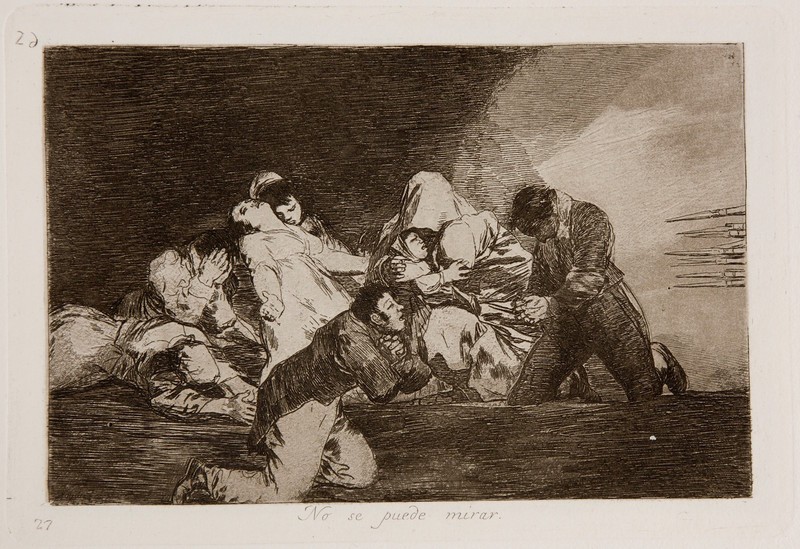- Cronología
- Ca. 1810 - 1812
- Dimensiones
- 145 x 210 mm
- Técnica y soporte
- Etching, burnished lavis, drypoint and burin
- Reconocimiento de la autoría de Goya
- Undisputed work
- Ficha: realización/revisión
- 02 Dec 2010 / 24 May 2023
- Inventario
- 225
Goya (lower left-hand corner), 27 (lower left-hand corner).
SeeSad presentiments of what must come to pass.
There is a third artist's proof that predates the writing, burnishing and scratches in the sky. The number 27 already appears in the lower left-hand corner.
The title was handwritten on the print by Goya in the first and only series that is known to have been printed at the time the works were created, which the artist gave to his friend Agustín Ceán Bermúdez. Therefore, the title was etched into the plate at a later date and left unchanged as of the first edition of the Disasters of War printed by the San Fernando Royal Academy of Fine Arts in Madrid in 1863, after the printing of the series in the possession of Ceán Bermúdez.
There is no surviving preparatory drawing of this print.
Goya ups the rhythm of The Disasters of War in this print with the depiction of a scene imbued with a strong, dramatic intensity that contrasts with the calm of previous prints in the series, which featured wounded people being assisted or corpses. The work shows the interior of a cave where various figures are going to be executed. On the left, a woman prostrates herself face down on the floor with her hands clasped on her head, while another covers her face and in front of them yet another woman stretches out her arms, her chest thrust out towards the enemy. In the middle of the composition there is a figure covered from head to foot holding a child in their arms. By their side is a kneeling man who brings his hands together in a gesture of prayer. In the centre of the foreground, another man begs for this torment to end. As in the case of print no. 15, And it can't be helped, here we see only the very ends of the bayonets that appear in a row in the right-hand side of the print.
The French soldiers are at the mouth of the cave where they have surprised the Spanish people they are about to execute. Once again, as in the case of other prints in this series, what should be a place of shelter that protects man has become a trap. The cave is a place that has hidden these people from their enemy for some time but has now become a dead end with no escape route. The short distance between the French and the Spanish figures means that they have to look at each other face-to-face.
The most striking figure in the print is the woman at the centre of the composition: facing death, she displays her torso, spreading out her arms in the form of a cross. This gesture is echoed in the central figure in the printThird of May 1808, who also wears a white shirt.
The plate is stored in the National Chalcography (cat. 277).
-
Goya. Das Zeitalter der Revolucionen. Kunst um 1800 (1980 – 1981)Hamburger KunsthalleHamburg1980cat. 78
-
Francisco de GoyaMuseo d'Arte ModernaLugano1996exhibition celebrated from September 22nd to November 17th.cat. 26
-
Francisco Goya. Sein leben im spiegel der graphik. Fuendetodos 1746-1828 Bordeaux. 1746-1996Galerie KornfeldBern1996from November 21st 1996 to January 1997cat. 114
-
Francisco Goya. Capricci, follie e disastri della guerraSan Donato Milanese2000Opere grafiche della Fondazione Antonio Mazzottacat. 106
-
Goya's RealismStatens Museum for KunstCopenhagen2000from February 11th to May 7th 2000cat. 40
-
Goya. La imagen de la mujerMuseo Nacional del PradoMadrid2001from October 30th 2001 to February 10th 2002. Exhibitied also at the National Gallery of Art, Washington, March 10th to June 2nd 2002, consultant editor Francisco Calvo Serrallercat. 110
-
Goya. Opera graficaPinacoteca del Castello di San GiorgioLegnano2006exhibition celebrated from December 16th 2006 to April 1st 2007p. 64
-
Goya en tiempos de guerraMuseo Nacional del PradoMadrid2008consultant editor Manuela B. Mena Marqués, from April 14th to July 13th 2008cat. 88
-
Goya et la modernitéPinacothèque de ParisParís2013from October 11st 2013 to March 16th 2014cat.65
-
Goya: Order and disorderMuseum of Fine ArtsBoston2014cat. 194
-
2022
-
Goya, grabadorMadridBlass S.A.1918cat. 128
-
Goya engravings and lithographs, vol. I y II.OxfordBruno Cassirer1964cat. 146
-
Vie et ouvre de Francisco de GoyaParísOffice du livre1970cat. 1037
-
Catálogo de las estampas de Goya en la Biblioteca NacionalMadridMinisterio de Educación y Cultura, Biblioteca Nacional1996cat. 228
-
ParísPinacoteca de París2013p. 132
-
Goya: Order & DisorderBostonMuseum of Fine Arts Boston Publications2014p. 289
-
Goya. In the Norton Simon MuseumPasadenaNorton Simon Museum2016pp. 114-151
-
Museo de Bellas Artes de Badajoz y Diputación de Badajoz2022p. 63
